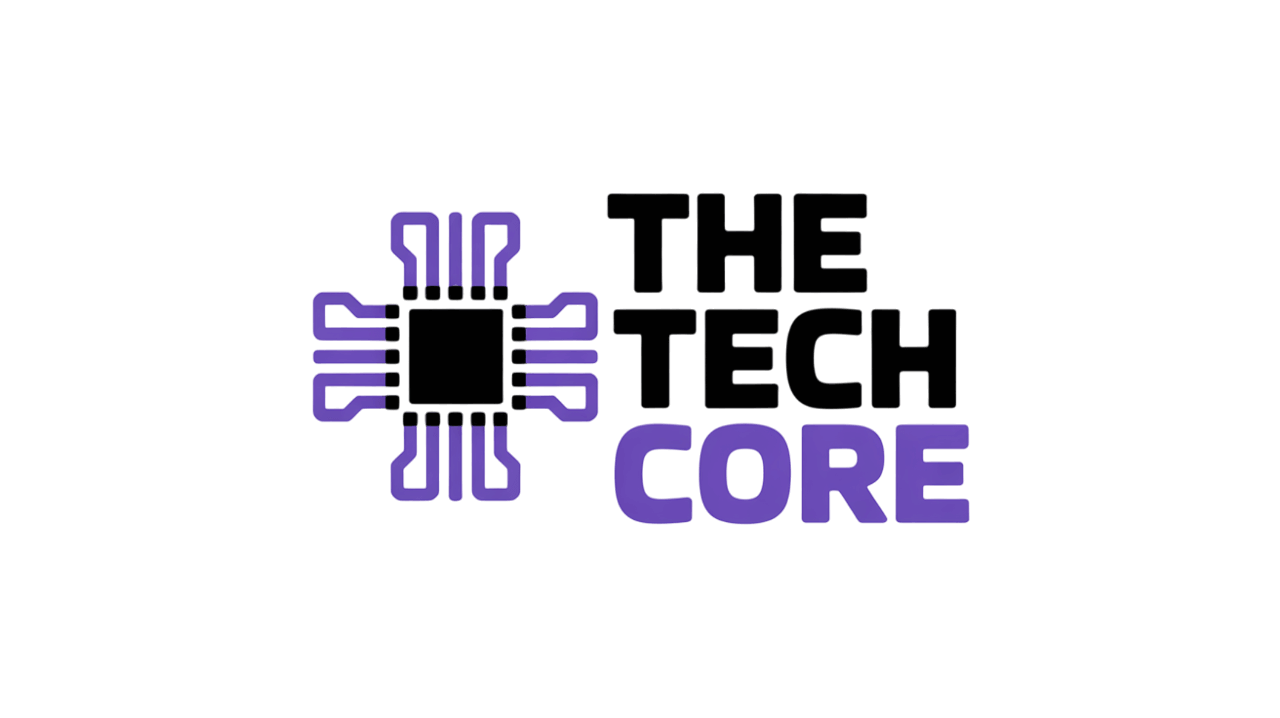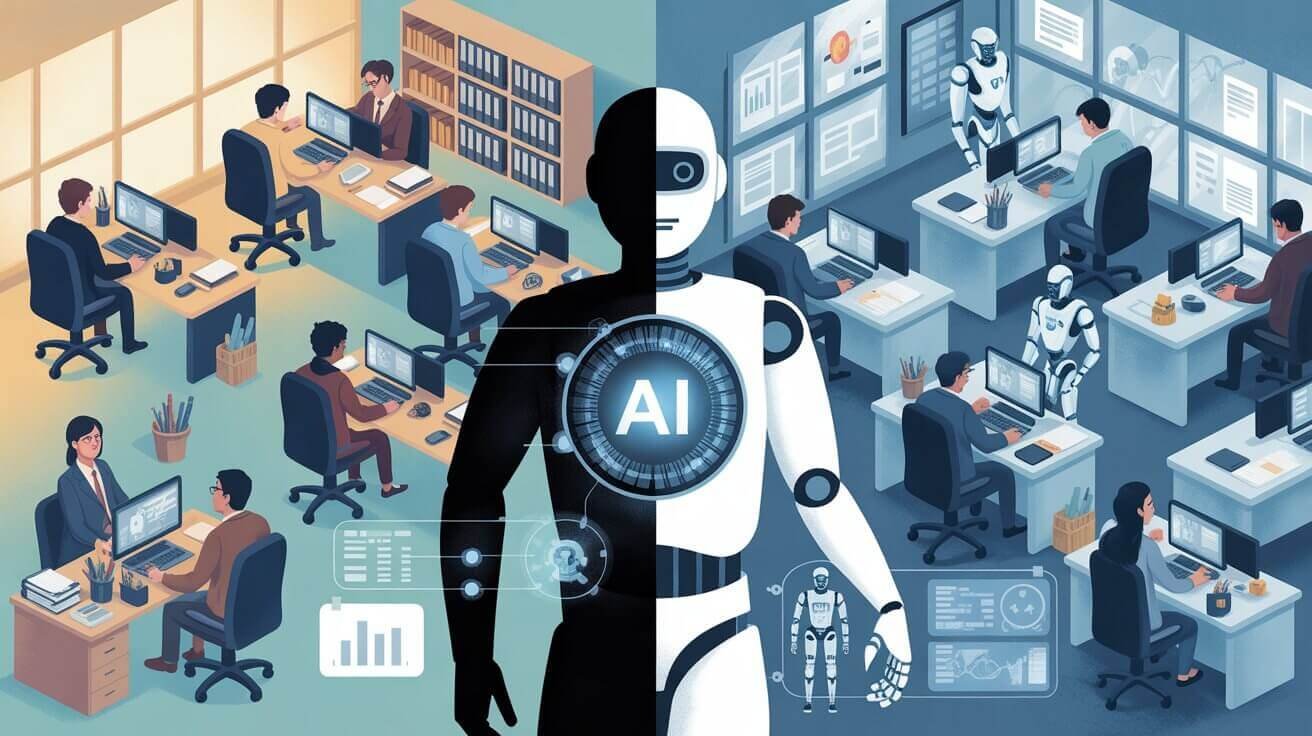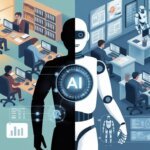How artificial intelligence is quietly reshaping the workplace while executives stay silent
AI job automation has moved from science fiction to your workplace reality, and companies are using artificial intelligence to transform entire industries faster than most people realize. While business leaders talk about “efficiency improvements” and “digital transformation,” AI job automation is fundamentally changing which jobs exist and who gets to keep them.
I’ve been tracking this shift for months, and the numbers tell a story that’s both fascinating and unsettling.
The quiet takeover happening right now
Here’s what caught my attention: companies aren’t being entirely honest about how they’re using AI to replace workers.
According to CNBC’s investigation, many recent “efficiency” layoffs hide a bigger AI automation story. Companies cut roles in content creation, customer service, and HR — exactly where generative AI tools work best — while calling it “restructuring” or “optimization.”
The truth is more stark. The World Economic Forum reports that 41% of employers worldwide plan to reduce their workforce in the next five years specifically due to AI automation.
That’s not five years from now. Companies are already making these changes.
Real companies, real automation, real impact
Let me show you what AI job automation looks like in practice across different industries.
Amazon’s warehouse revolution Amazon operates over 200,000 Kiva robots in fulfillment centers. These AI-powered machines use computer vision and route optimization to handle inventory, cutting fulfillment costs by 20%. The result? Faster shipping, but fewer human warehouse workers needed.
JPMorgan’s legal automation JPMorgan’s COiN system uses natural language processing to review legal contracts. This AI automation tool saves 360,000 human hours annually with less than 1% error rate. Those are hours that legal assistants and paralegals used to bill.
Tesla’s manufacturing AI Tesla’s factories use computer vision for quality control and collaborative robots for assembly. Manufacturing automation reduced Model Y assembly time from 10 hours to 4 hours. Fewer workers needed per car produced.
The jobs disappearing fastest
AI automation isn’t affecting all jobs equally. The pattern is clear when you look at the data.
Entry-level positions hit hardest Research shows that MIT predicts AI will replace 2 million manufacturing workers by 2025. But white-collar entry-level jobs face even bigger challenges because they’re data-heavy and rule-based.
Customer service transformation Companies now handle millions of customer interactions through AI chatbots. IBM’s AskHR system manages 11.5 million interactions annually with minimal human oversight. When you call customer service, you’re increasingly talking to AI automation, not people.
Content and data work AI tools can generate product descriptions, process documents, and analyze data faster than human workers. Companies like Meta, Microsoft, and Salesforce increasingly use AI for coding tasks that junior developers used to handle.
The human cost behind the efficiency gains
The numbers show real people losing real jobs to AI automation.
Klarna’s CEO admitted publicly that his company shrunk from 5,000 to 3,000 employees as AI systems took over customer service and back-office functions. That’s 2,000 people whose jobs disappeared to automation.
TCS, India’s largest IT company, plans to cut 12,000 employees — 2% of their workforce — as AI automation eliminates traditional testing and project management roles.
But here’s what worries me most: these companies frame job cuts as “deploying the right people with future-ready skills” rather than acknowledging that AI automation is eliminating positions entirely.
The skills gap that’s getting wider
AI job automation creates a troubling dynamic for workers trying to stay relevant.
The education paradox According to research, 77% of new AI-related jobs require master’s degrees, and 18% require doctoral degrees. Meanwhile, the entry-level positions that used to provide career pathways keep disappearing to automation.
The wage premium for AI skills PwC’s analysis shows workers with AI skills earn 43% more than those without. But this creates a two-tier system where AI automation increases inequality between workers who can adapt and those who can’t.
The speed of change problem Skills in AI-exposed jobs change 25% faster than before. Workers must constantly retrain just to keep up with AI automation advances, creating exhausting pressure to stay current.
Industries transformed by AI automation
Let me walk you through how workplace automation affects different sectors.
Healthcare gets surgical precision AI assists with diagnostics, patient monitoring, and treatment planning. Companies like IBM Watson Health analyze medical images faster than human radiologists, while AI handles appointment scheduling and insurance processing.
Financial services automate decisions Banks use AI for fraud detection, loan approvals, and algorithmic trading. Goldman Sachs and BlackRock employ AI systems that predict market trends and execute trades without human traders.
Retail eliminates checkout Amazon Go stores use computer vision to track purchases automatically. Self-checkout systems and inventory robots reduce staffing needs while AI handles demand forecasting and supply chain optimization.
The productivity paradox nobody discusses
Here’s something interesting: AI automation increases productivity, but the benefits don’t reach most workers.
McKinsey research estimates AI could add $4.4 trillion in productivity growth globally. But this productivity comes from replacing human labor with AI automation, not from making existing workers more effective.
Companies see AI automation as cost reduction rather than workforce enhancement. The result? Higher profits for shareholders while workers face job displacement and wage stagnation.
What companies won’t tell you about AI strategy
I’ve noticed a pattern in how business leaders discuss AI automation publicly versus privately.
The public narrative Executives talk about “human-AI collaboration” and “augmenting human capabilities.” They emphasize that AI automation will create new jobs and make work more interesting.
The private reality Internal surveys show 78% of companies use AI in at least one business function, with most applications focused on replacing human tasks rather than enhancing human work.
The strategic silence Companies avoid linking layoffs directly to AI automation because it invites employee backlash and regulatory scrutiny. “Efficiency improvements” sounds better than “AI replaced your job.”
The new job categories emerging
AI automation does create some new positions, but they’re different from what disappeared.
AI specialists and engineers Companies need people who can build, maintain, and improve AI systems. But these roles require advanced technical skills that most displaced workers don’t have.
Human oversight roles AI systems need human monitoring for quality control and ethical compliance. However, one oversight specialist can manage work that previously required dozens of people.
Creative and strategic positions Jobs requiring complex problem-solving, creativity, or interpersonal skills remain harder to automate. But these represent a small fraction of the workforce.
The geographic shift in work
AI automation affects different regions differently, creating new patterns of employment.
Developed economies lead automation Countries with high labor costs adopt AI automation faster. PwC research shows advanced economies like Western Europe and Australia achieve better cybersecurity outcomes through AI implementation.
Emerging markets face disruption Developing countries that rely on manufacturing and call center work see jobs move to AI automation rather than higher-wage countries. This disrupts traditional economic development paths.
Remote work changes everything AI automation combines with remote work to create global competition for knowledge work. Companies can now choose between hiring humans anywhere or implementing AI automation instead.
The psychological impact on workers
Beyond economics, AI automation creates emotional and psychological challenges for workers.
Constant adaptation pressure Workers report feeling exhausted by the need to continuously learn new skills to stay ahead of AI automation. The pace of change feels unsustainable for many people.
Job security anxiety Even workers whose jobs aren’t immediately threatened by AI automation worry about future displacement. This uncertainty affects mental health and career planning.
Identity and purpose questions When AI automation handles tasks that previously defined someone’s professional identity, workers struggle to find meaning in their remaining responsibilities.
Government responses to AI automation
Policymakers are beginning to address AI job automation, but responses vary widely.
Skills training initiatives The White House launched pledges for companies to invest in AI training programs. 68 firms have committed to preparing workers for the AI era through education initiatives.
Regulatory frameworks Some countries consider universal basic income or job transition assistance as AI automation accelerates. However, political consensus remains limited.
International coordination Global organizations like the World Economic Forum track AI automation trends, but international cooperation on workforce policies lags behind technological change.
What this means for your career
If you’re wondering how AI automation might affect your work, here are the patterns I see:
High-risk positions Jobs involving data entry, routine analysis, content creation, and customer service face immediate AI automation pressure. These tasks follow predictable patterns that machines handle well.
Medium-risk roles Positions requiring some creativity or judgment but with clear outputs — like junior marketing, basic accounting, or entry-level programming — see partial AI automation that reduces headcount needs.
Lower-risk work Jobs requiring complex interpersonal skills, physical presence, or highly creative problem-solving remain harder to automate. But these often require different qualifications than the jobs being automated.
The skills that matter now
Based on industry trends, certain capabilities become more valuable as AI automation advances:
AI literacy and collaboration Understanding how to work with AI tools effectively becomes essential. Workers who can leverage AI automation for better results outperform those who resist the technology.
Complex problem-solving Tasks requiring synthesis of multiple information sources, creative solutions, or nuanced judgment remain human strengths that complement AI automation.
Emotional intelligence and communication Interpersonal skills become more valuable as routine communication gets automated. Human connection remains irreplaceable for complex negotiations, leadership, and relationship building.
The economic implications
AI automation affects entire economic systems, not just individual jobs.
Productivity versus employment Higher productivity from AI automation could theoretically benefit everyone through lower costs and new innovations. But the transition period creates significant displacement and inequality.
Tax and social systems Traditional employment-based benefits and tax systems don’t work well when AI automation reduces the number of jobs. This requires fundamental policy changes.
Consumer demand If AI automation eliminates jobs faster than it creates new ones, consumer spending could decline, creating a feedback loop that slows economic growth.
Looking ahead: what happens next
Several trends will shape how AI automation develops over the next few years:
Acceleration of adoption McKinsey data shows that 92% of companies plan to increase AI investments over the next three years. This means more workplace automation, not less.
Regulatory responses As AI automation effects become more visible, governments will likely introduce new policies around job displacement, retraining, and social support systems.
Technology maturation AI systems will become more capable and easier to deploy, making automation accessible to smaller companies that previously couldn’t afford it.
The bottom line for workers
AI job automation represents the biggest change to work since the Industrial Revolution. Unlike previous technological shifts, AI can potentially automate cognitive tasks that we thought were uniquely human.
Companies are already using AI automation to reduce workforce needs, but they’re not always transparent about these decisions. The pace of change is accelerating, and the effects reach beyond individual jobs to entire industries and economic systems.
Workers who understand this shift and adapt proactively have better chances of thriving. Those who ignore AI automation or hope it won’t affect their work may find themselves unprepared for changes that are already happening.
The conversation about AI and jobs often focuses on distant predictions. But AI job automation is reshaping workplaces right now. The question isn’t whether this change will happen — it’s how quickly you’ll adapt to the new reality.
Your career success increasingly depends on understanding how AI automation works, where it’s headed, and how you can position yourself to benefit rather than be displaced by these changes.
The future of work is being written today, one algorithm at a time.








